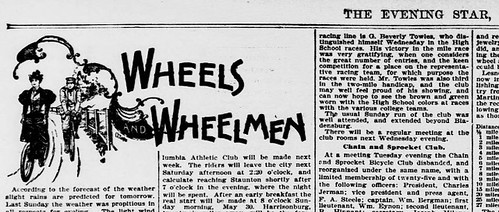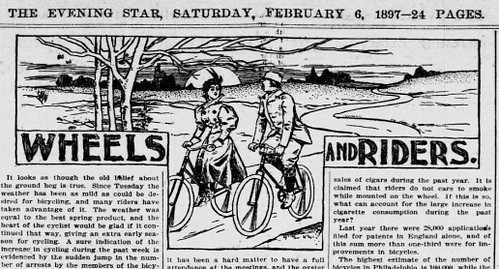
A full page for cyclists in a Washington newspaper of 1897
The full page of articles from this May 22 issue, for example, covers the problem of crowds of riders on the weekend during good weather in May, and particularly police activities to control "scorchers."
According to the forecast of the weather slight rains are predicted for tomorrow. Last Sunday the weather was propitious in all respects for cycling. The light wind which prevailed the greater part of the day was just sufficient to keep the riders from becoming overheated. An unusually large number of cyclists were out on the roads. Maying parties were numerous and the hunt for the pretty wild flowers seemed to have particular fascination for the riders of the fair sex.A "Maying party" was apparently just a picnic organized in May, according to "The Complete Hostess" of 1912.
. . . It is understood that the entire police cycle squad of the city have been ordered out on the Conduit road for duty tomorrow. They will endeavor to suppress the scorchers. and in this laudable undertaking they will have the support of the largest number of riders for pleasure purposes only. The arrest of a dozen or more scorchers would have a salutary effect, and doubtless put a stop to the practice for a week or so at least.
In this connection an amusing story is told of an occurrence that happened last Sunday. There were several tandems coming down the road at an eighteen-mile-an-hour gait, when one of the mounted members of the county police force called upon them to slacken their speed. Just as the scorchers passed by the policeman he heard one of the riders urge the others to keep on, telling them that the cop would never be able to catch them. In this the riders were sadly mistaken. The policeman quickly jumped on his horse, and in an instant was after the two tandem teams. With a l00 yards start of him the policeman caught the men inside of 300 yards, and fearing the result the riders of both tandems ran their machine over in a ditch, fortunately escaping injury. They were a very humble and penitent set, and, after considerable pleading, were allowed to go. According to the policeman's theory he can overtake any scorcher on the road. They can cover a mile in something like 2.50 says he, while he would not use a horse which could not run the distance in two minutes or under, for cases of emergency. The other members of the mounted county police force are equally well mounted.

A full page for cyclists from the Washington "Evening Star" in February 1897, in advance or the "cycling season"
These pages often give statistical information about the scale of cycling at the time, which is interesting up to the point where I realize I don't have much of a sense of the modern day equivalents. Also, in 1897 most of the bicycles that would have been purchased would have been used, while today most bicycles in America are in some version of long term storage most of the time. The page from which the graphic shown above was taken includes this:
With a basis of 40,000 wheelmen and wheel women in the city, the following would represent the aggregate cost of bicycles in the District of Columbia alone:
Cost of wheels $3,200,000
Cost of lamps $ 100,000
Cost of bells $ 10,000
Cost of oil and wicks $ 10,000
Cost of costumes and caps $ 600,000
Cost of shoes $ 100,000
Cost of stockings $ 40,000
Cost of repairs $ 120,000
Cost of incidentals $ 200,000
Total outlay for cycling $4,380,000
No comments:
Post a Comment